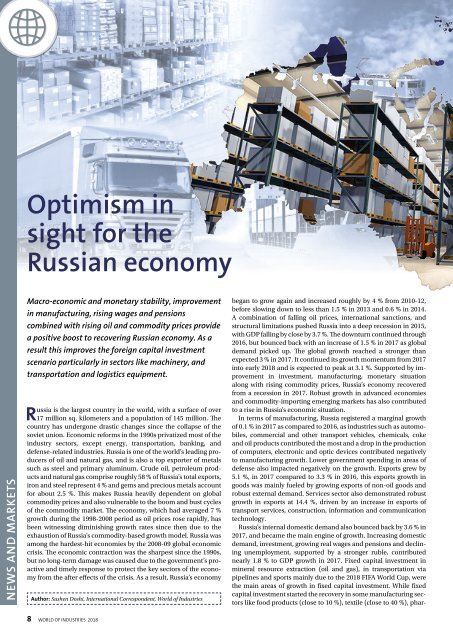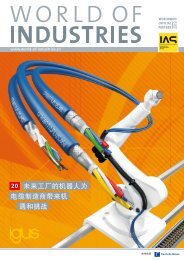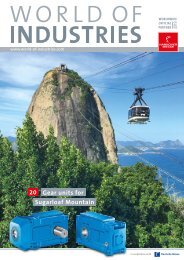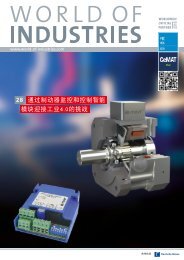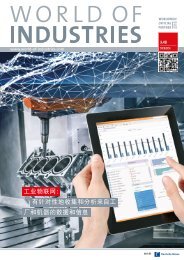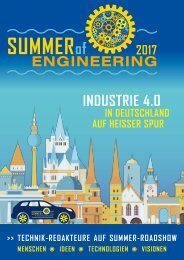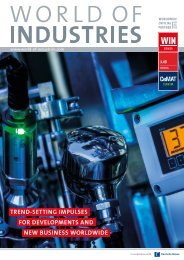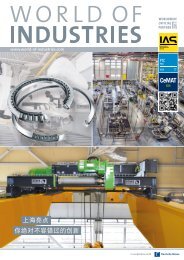WORLD OF INDUSTRIES 06/2018 (RU)
WORLD OF INDUSTRIES 06/2018 (RU)
WORLD OF INDUSTRIES 06/2018 (RU)
- No tags were found...
Create successful ePaper yourself
Turn your PDF publications into a flip-book with our unique Google optimized e-Paper software.
Optimism in<br />
sight for the<br />
Russian economy<br />
NEWS AND MARKETS<br />
Macro-economic and monetary stability, improvement<br />
in manufacturing, rising wages and pensions<br />
combined with rising oil and commodity prices provide<br />
a positive boost to recovering Russian economy. As a<br />
result this improves the foreign capital investment<br />
scenario particularly in sectors like machinery, and<br />
transportation and logistics equipment.<br />
R<br />
ussia is the largest country in the world, with a surface of over<br />
17 million sq. kilometers and a population of 145 million. The<br />
country has undergone drastic changes since the collapse of the<br />
soviet union. Economic reforms in the 1990s privatized most of the<br />
industry sectors, except energy, transportation, banking, and<br />
defense-related industries. Russia is one of the world’s leading producers<br />
of oil and natural gas, and is also a top exporter of metals<br />
such as steel and primary aluminum. Crude oil, petroleum products<br />
and natural gas comprise roughly 58 % of Russia’s total exports,<br />
iron and steel represent 4 % and gems and precious metals account<br />
for about 2.5 %. This makes Russia heavily dependent on global<br />
commodity prices and also vulnerable to the boom and bust cycles<br />
of the commodity market. The economy, which had averaged 7 %<br />
growth during the 1998-2008 period as oil prices rose rapidly, has<br />
been witnessing diminishing growth rates since then due to the<br />
exhaustion of Russia’s commodity-based growth model. Russia was<br />
among the hardest-hit economies by the 2008-09 global economic<br />
crisis. The economic contraction was the sharpest since the 1990s,<br />
but no long-term damage was caused due to the government’s proactive<br />
and timely response to protect the key sectors of the economy<br />
from the after effects of the crisis. As a result, Russia’s economy<br />
Author: Sushen Doshi, International Correspondent, World of Industries<br />
began to grow again and increased roughly by 4 % from 2010-12,<br />
before slowing down to less than 1.5 % in 2013 and 0.6 % in 2014.<br />
A combination of falling oil prices, international sanctions, and<br />
structural limitations pushed Russia into a deep recession in 2015,<br />
with GDP falling by close by 3.7 %. The downturn continued through<br />
2016, but bounced back with an increase of 1.5 % in 2017 as global<br />
demand picked up. The global growth reached a stronger than<br />
expected 3 % in 2017. It continued its growth momentum from 2017<br />
into early <strong>2018</strong> and is expected to peak at 3.1 %. Supported by improvement<br />
in investment, manufacturing, monetary situation<br />
along with rising commodity prices, Russia’s economy recovered<br />
from a recession in 2017. Robust growth in advanced economies<br />
and commodity-importing emerging markets has also contributed<br />
to a rise in Russia’s economic situation.<br />
In terms of manufacturing, Russia registered a marginal growth<br />
of 0.1 % in 2017 as compared to 2016, as industries such as automobiles,<br />
commercial and other transport vehicles, chemicals, coke<br />
and oil products contributed the most and a drop in the production<br />
of computers, electronic and optic devices contributed negatively<br />
to manufacturing growth. Lower government spending in areas of<br />
defense also impacted negatively on the growth. Exports grew by<br />
5.1 %, in 2017 compared to 3.3 % in 2016, this exports growth in<br />
goods was mainly fueled by growing exports of non-oil goods and<br />
robust external demand. Services sector also demonstrated robust<br />
growth in exports at 14.4 %, driven by an increase in exports of<br />
transport services, construction, information and communication<br />
technology.<br />
Russia’s internal domestic demand also bounced back by 3.6 % in<br />
2017, and became the main engine of growth. Increasing domestic<br />
demand, investment, growing real wages and pensions and declining<br />
unemployment, supported by a stronger ruble, contributed<br />
nearly 1.8 % to GDP growth in 2017. Fixed capital investment in<br />
mineral resource extraction (oil and gas), in transportation via<br />
pipelines and sports mainly due to the <strong>2018</strong> FIFA World Cup, were<br />
the main areas of growth in fixed capital investment. While fixed<br />
capital investment started the recovery in some manufacturing sectors<br />
like food products (close to 10 %), textile (close to 40 %), phar-<br />
8 <strong>WORLD</strong> <strong>OF</strong> <strong>INDUSTRIES</strong> <strong>2018</strong>


